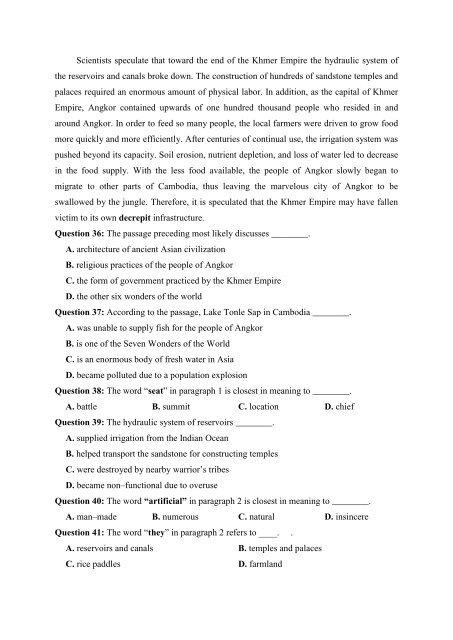Bộ đề thi thử THPTQG năm 2018 - Môn Tiếng Anh - 20 ĐỀ + ĐÁP ÁN - GV Kiều Thị Thắng - Tuyensinh247
https://app.box.com/s/fdml0d4t6lk8t30qzh0xow50qpjgs63c
https://app.box.com/s/fdml0d4t6lk8t30qzh0xow50qpjgs63c
You also want an ePaper? Increase the reach of your titles
YUMPU automatically turns print PDFs into web optimized ePapers that Google loves.
Scientists speculate that toward the end of the Khmer Empire the hydraulic system of<br />
the reservoirs and canals broke down. The construction of hundreds of sandstone temples and<br />
palaces required an enormous amount of physical labor. In addition, as the capital of Khmer<br />
Empire, Angkor contained upwards of one hundred thousand people who resided in and<br />
around Angkor. In order to feed so many people, the local farmers were driven to grow food<br />
more quickly and more efficiently. After centuries of continual use, the irrigation system was<br />
pushed beyond its capacity. Soil erosion, nutrient depletion, and loss of water led to decrease<br />
in the food supply. With the less food available, the people of Angkor slowly began to<br />
migrate to other parts of Cambodia, thus leaving the marvelous city of Angkor to be<br />
swallowed by the jungle. Therefore, it is speculated that the Khmer Empire may have fallen<br />
victim to its own decrepit infrastructure.<br />
Question 36: The passage preceding most likely discusses ________.<br />
A. architecture of ancient Asian civilization<br />
B. religious practices of the people of Angkor<br />
C. the form of government practiced by the Khmer Empire<br />
D. the other six wonders of the world<br />
Question 37: According to the passage, Lake Tonle Sap in Cambodia ________.<br />
A. was unable to supply fish for the people of Angkor<br />
B. is one of the Seven Wonders of the World<br />
C. is an enormous body of fresh water in Asia<br />
D. became polluted due to a population explosion<br />
Question 38: The word “seat” in paragraph 1 is closest in meaning to ________.<br />
A. battle B. summit C. location D. chief<br />
Question 39: The hydraulic system of reservoirs ________.<br />
A. supplied irrigation from the Indian Ocean<br />
B. helped transport the sandstone for constructing temples<br />
C. were destroyed by nearby warrior’s tribes<br />
D. became non–functional due to overuse<br />
Question 40: The word “artificial” in paragraph 2 is closest in meaning to ________.<br />
A. man–made B. numerous C. natural D. insincere<br />
Question 41: The word “they” in paragraph 2 refers to ____. .<br />
A. reservoirs and canals B. temples and palaces<br />
C. rice paddles D. farmland


















